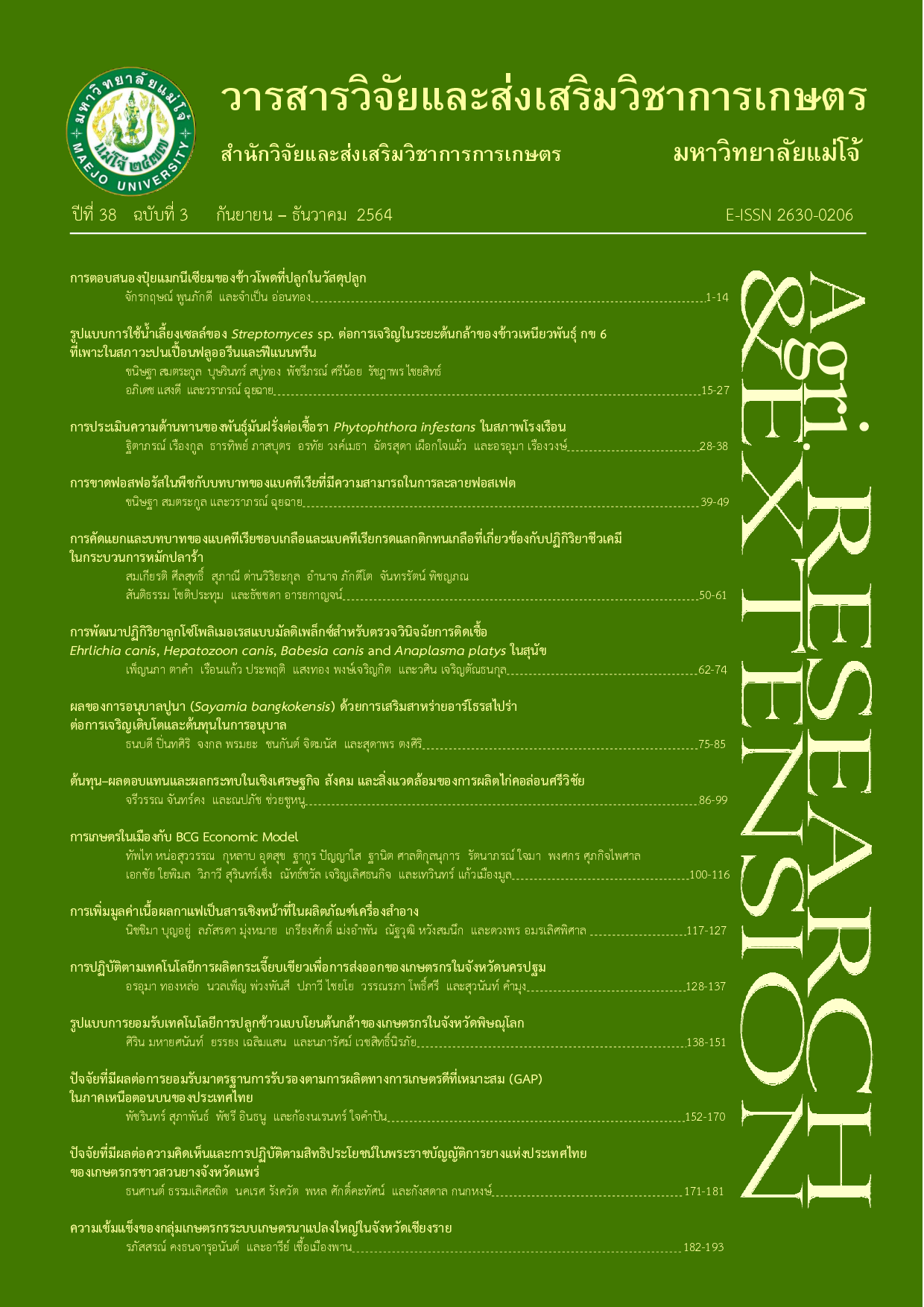ผลของการอนุบาลปูนา (Sayamia bangkokensis) ด้วยการเสริมสาหร่ายอาร๋โธรสไปร่า ต่อการเจริญเติบโตและต้นทุนในการอนุบาล
คำสำคัญ:
ปูนา, อาร์โธรสไปร่า, การอนุบาลบทคัดย่อ
การศึกษาผลของสาหร่ายอาร์โธรสไปร่าในอาหารต่อการเจริญเติบโตและต้นทุนการอนุบาลลูกปูนา (Sayamia bangkokensis) โดยวางแผนการทดลอง แบบสุ่มตลอด (Complete Randomized Design; CRD) แบ่งเป็น 4 ชุดการทดลองๆ ละ 3 ซ้ำ คือ ชุดการทดลองที่ 1 (ชุดควบคุม) อาหารเม็ดสำเร็จรูป (Pellet feed; PF) ชุดการทดลองที่ 2, 3 และ 4 อาหารเม็ดสำเร็จรูปผสมสาหร่ายอาร์โธรสไปร่าผง 3, 5 และ 10% (Pellet feed mixed with dry Arthrospira; PFA 3%, PFA 5% and PFA 10%) ตามลำดับ ลูกปูนามีน้ำหนักเริ่มต้นเฉลี่ย 0.0082±0.0002 กรัม/ตัว อนุบาลในกะละมังทรงกลม ความหนาแน่น 25 ตัว/กะละมัง หรือ 385 ตัว/ตรม. โดยอนุบาลเป็นระยะเวลา 60 วัน เก็บข้อมูลโดยการชั่งน้ำหนัก วัดความยาว และความกว้างกระดอง (Carapace) ของ ลูกปูนาทุกๆ 10 วัน พบว่าลูกปูนาที่อนุบาลด้วยอาหารผสมอาร์โธรสไปร่าผง 5% (PFA 5%) มีน้ำหนักที่เพิ่มขึ้นเฉลี่ย 1.2900±0.2011 กรัม/ตัว อัตราการเจริญเติบโตต่อวัน 0.021±0.0033 กรัม/ตัว/วัน อัตราการเจริญเติบโตจำเพาะ 2.1500±0.3351% อัตราการแลกเนื้อ 0.9200±0.2007 ประสิทธิภาพในการใช้โปรตีน 0.0342±0.0053 และอัตราการรอด 87.33±1.2018% ดีกว่าชุดการทดลองอื่น อย่างมีนัยสำคัญทางสถิติ (p<0.05) คุณภาพน้ำ และ ต้นทุนการผลิตลูกปูนาทั้ง 4 ชุดการทดลองอยู่ระหว่าง 2.0320±0.4351 - 3.4998±0.2356 บาท/ตัว ซึ่งไม่มีความแตกต่างทางสถิติ (p>0.05) สรุปได้ว่าการอนุบาลลูกปูนาด้วยอาหารเม็ดสำเร็จรูปผสมสาหร่ายอาร์โธรสไปร่าผง 5% ช่วยให้มีการเจริญเติบโตดีที่สุด รวมถึงต้นทุนการอนุบาลที่เหมาะสมเพื่อพัฒนามาใช้เป็นสูตรอาหารในการอนุบาลลูกปูนาต่อไป
เอกสารอ้างอิง
AOAC. 2000. Official Methods of Analysis. 17th edition. Maryland: AOAC.
Boyd, D. and C. Tucker. 1992. Water Quality and Pond Soil Analysis for Aquacult. Alabama: Auburn University. 183 p.
Cannicci, S. 1996. Natural diet and feeding habits of Thalamita crenata. J. Crustacean Biol 16(4): 678-683.
Choubert, G. 1979. Tentative utilization of Spirulina algae as a source of carotenoid pigments for rainbow trout. International J. AGR. Biol 18: 135-143.
Dulyachindachabaporn, S., P. Charuratchamorn, K. Somnai and T. DunchindaChabaporn. 2001. Study of the age and growth of Natural food. pp. 260-265. In Proceedings of The 39th Kasetsart University Annual Conference (Abstract). Bangkok: Kasetsart University. [in Thai]
Hangsapreuke, K. 2013. Nursing of giant freashwater prawn (Macrobrachium rosenbergii) using spirulina in a closed recirculating system. 49 p. In Research Report. Chiang Mai: Maejo University. [in Thai]
Hemanon, P., M. Kanarong., S. Trikheet and I. Hemanon. 2004. Effects of Arthrospira platensis in prawn (Penaeus merguiensis) post larva range. 10 p. In Research Report. Nakhon Si Thammarat: Inland Aquaculture Research and Department Center, Nakhon Si Thammarat Department of Fisheries. [in Thai]
Lee, D. 1971. Studies on the protein utilization related to growth of Penaeus monodon Fabricius. International J. AGR. Biol. 1: 1-13.
Liuliomon, K. 1986. Algae research in Thailand. Kasetsart J. Sci. Technol. 3(3):144-148. [in Thai]
Nakamura, H. 1982. Spirulina: Food for a Hungry World, A Pioneer’s Story in Aquaculture. Boulder Cheek, California: Universisty of the Trees Press. 215 p.
Pachanawan, A. and S. Khampuch. 2008. Effects of sex on growth and molting of rice-field crabs. Fisheries J. Sci. Technol.2(1): 88-92. [in Thai]
Phakdinarong, N., P. Chantirikul and A. Chantirikul. 2009. Natural diet of the rice-field crab, Esanthelphusa dugasti Rathbun, 1902 in rainy season. Khon Kaen J. AGR. 37(1): 49-55. [in Thai]
Pintasiri, T. and J. Promya. 2019. Effects of Arthrospira platensis supplemented diets on growth performance of rice-field crabs (Sayamia bangkokensis). Khon Kaen J. AGR. 47(Suppl.2): 7-14. [in Thai]
Pinthasiri, T. and K. Srinaunsom. 2019 Using spirulina (Arthrospira) to be supplemented diets the cultivation of rice-field crabs (Sayamia bangkokensis). Maejo J. Review 20(3): 32-36. [in Thai]
Pornchalermpong, P. and N. Rattanapanon. (n.d.). Full food information network center. [Online]. Available http://www. foodnetworksolution.com/wiki/word/1647/ linoleic-acid.com (7 February 2020). [in Thai]
Promkunthong, W. and A. Pipattanwattankhul. 2005. Results of Arthrospira alga on growth and antibody levels in mixed breed pellets feed (Clarias macrocephalus x Clasrias gariepinus (Burchell). Songklanakarin J. Sci. Technol. 27: 115-132.
Promya, J., N. Wangchai and T. Ungsethaphan. 2005. Increase the Production of Giant Freashwater Prawn (Macrobrachium rosenbergii) the Earthen Pond by Rising together with Artificial Materials to Increase the Safe Area while the Molting Shrimp. pp. 29-41. In Proceedings of The 6th Maejo University Conference (Oral). Chiang Mai: Maejo University. [in Thai]
Promya, J. 2009. Culture of algae. 228 p. In Research Report. Chiang Mai: Maejo University. [in Thai]
Promya, J. and C. Chitmanat. 2011. The effects of Arthrospira platensis and Cladophora algae on the growth performance meat quality and immunity stimulating capacity of the African sharp tooth pellets feed (Clarias gariepinus). International J. AGR. Biol 13: 77-82.
Thaiso, K. and S. Wongmaniprathip. 2012. Effects of different protein sources on growth and survival rates of rice field crab (Esanthelphusa dugasti) nursing. Khon Kaen J. AGR. 40(Suppl.): 123-128. [in Thai]
Venkataraman, L. 1983. A Monograph on Spirulina platensis. Mysore: Central Food Technological Research Institute. 100 p.
ดาวน์โหลด
เผยแพร่แล้ว
รูปแบบการอ้างอิง
ฉบับ
ประเภทบทความ
สัญญาอนุญาต
ลิขสิทธิ์ (c) 2021 วารสารวิจัยและส่งเสริมวิชาการเกษตร

อนุญาตภายใต้เงื่อนไข Creative Commons Attribution-NonCommercial-NoDerivatives 4.0 International License.
บทความนี้ได้รับการเผยแพร่ภายใต้สัญญาอนุญาต Creative Commons Attribution-NonCommercial-NoDerivatives 4.0 International (CC BY-NC-ND 4.0) ซึ่งอนุญาตให้ผู้อื่นสามารถแชร์บทความได้โดยให้เครดิตผู้เขียนและห้ามนำไปใช้เพื่อการค้าหรือดัดแปลง หากต้องการใช้งานซ้ำในลักษณะอื่น ๆ หรือการเผยแพร่ซ้ำ จำเป็นต้องได้รับอนุญาตจากวารสาร





